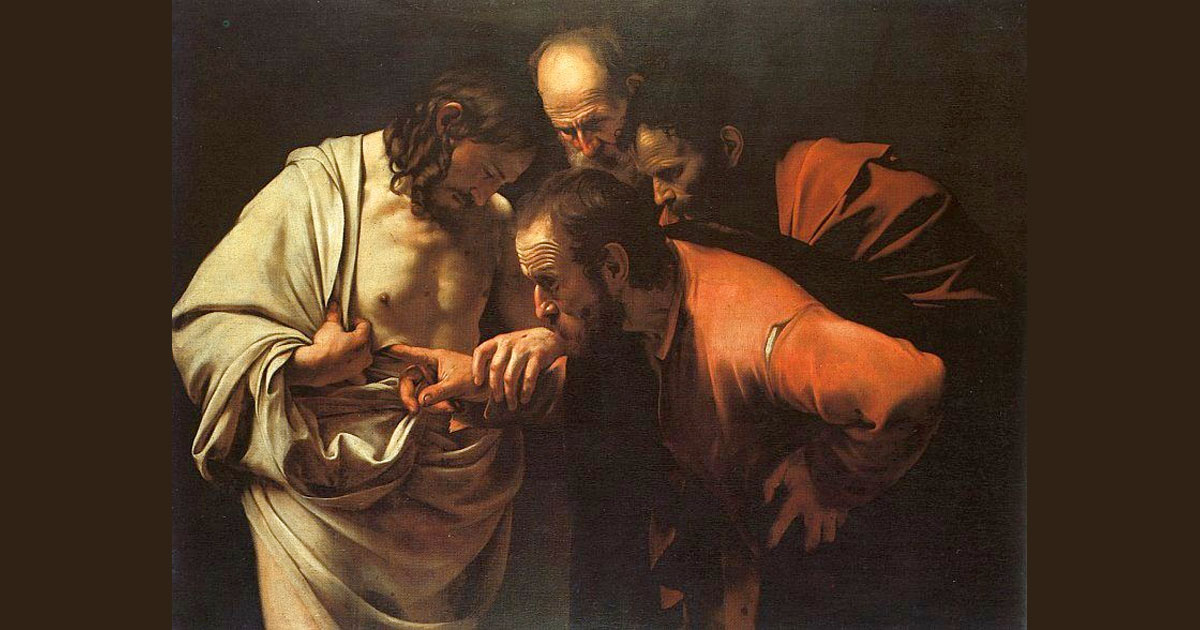St. Vincent de Paul’s Inner “Doubting Thomas”
Re-imaging the story of “Doubting Thomas
I thought I knew the meaning of the story of “doubting Thomas.” That is until I read ‘Like Thomas, I Don’t Always Believe’ by Ryan Henderson Espinoza. Now I doubt if I can ever read the passage unique to John’s Gospel without thinking of this reflection.
The key insight for me is that Thomas needed direct experience of the wounds of Jesus to believe in the Resurrection. Paradoxically it was the vicarious experience touching the wounds of Jesus sufferings that allowed him to believe in Christ’s Resurrection and the victory over sin and death.
Ponder these words…
… when Thomas discovered he couldn’t fully believe, he sought out the direct experience he needed to bridge the remaining distance. In other words, Thomas got his hands dirty in order to believe.
What happens when Thomas sinks his fingers into the wounded side of the Risen One? In these few short moments, a kind of transformation occurs; Thomas was changed because of firsthand experience—literally. What Thomas touched with his fingers allowed him to believe.
Experiencing the wounds of Christ was the key to belief and transformation!
The challenge to get our hands dirty and touch his wounds today
Now listen to the way Pope Francis describes the wounds of the body of Christ today…
And for today’s followers of the Way, this points to an important practice: experience. Without experience of the ongoing realities of injustice around us, such as homelessness (which disproportionately impacts youth and children), or a lack of access to health care (which impacts almost all of us), or any other structures of evil that keep us from fully flourishing, we cannot imagine a different future or even a different now.
And now it’s our job to touch the wounds caused by homelessness, poverty, white supremacy, global capitalism, climate change, the separation of children from their parents at the border, and gentrification—and believe the future can be different.
.. when I come close to suffering and actually sink my hands into the wounds of this world, I am transformed. I am renewed and come to have hope in a different world, one where the reign of God is made manifest right before my eyes. May you go and do likewise!
Pope Francis’ meditations on the way of the cross written by prisoners, those who care for them and this whose lives have been ruined by them.
Listen to Pope Francis as he lists some of the wounds to the Mystical Body of today…
In our own day, whole peoples suffer hunger and thirst, and we are haunted by pictures of children with nothing to eat. Throngs of people continue to migrate from one country to another in search of food, work, shelter and peace. Disease in its various forms is a constant cause of suffering that cries out for assistance, comfort and support. Prisons are often places where confinement is accompanied by serious hardships due to inhumane living conditions. Illiteracy remains widespread, preventing children from developing their potential and exposing them to new forms of slavery. The culture of extreme individualism, especially in the West, has led to a loss of a sense of solidarity with and responsibility for others. Today many people have no experience of God himself, and this represents the greatest poverty and the major obstacle to recognition of the inviolable dignity of human life.
… Mercy impels us to roll up our sleeves and set about restoring dignity to millions of people; they are our brothers and sisters who, with us, are called to build a “city which is reliable”. (Exhortation for the Second World Day of the poor #19)
What St. Vincent and Thomas have in common?
St. Vincent did not always understand his contacts with people who were suffering… until he put his hands into their wounds.
Vincent de Paul thought he knew what he wanted from life. Events of Chatilon and Follevile woke him up to the reality of spiritual abandonment and physical misery of those on the margins. But the insights of Chatillon and Folleville took him a lifetime to unpack. In his later years, he spoke often of his constant amazement as he unpacked the connection with subsequent events.
- He may not have used the words “the mystical body of Christ.
- He may not have connected the story of Thomas putting his hands into Jesus’ wounds as the path to belief in the resurrection.
- He came to believe deeply in what we call today the mystical Body fo Christ. The poor and their wounds that brought home to him the reality of the suffering of Christ in his resurrected body.
When Vincent put his hands in Christ’s wounds he realized he was touching the body of Christ.
Touching the wounds of Christ today…
- Can we acknowledge our own need to touch the wounds of Christ’s Mystical Body today?
- Do we allow ourselves to be transformed when we put our hands into Christ’s wounds today?







0 Comments